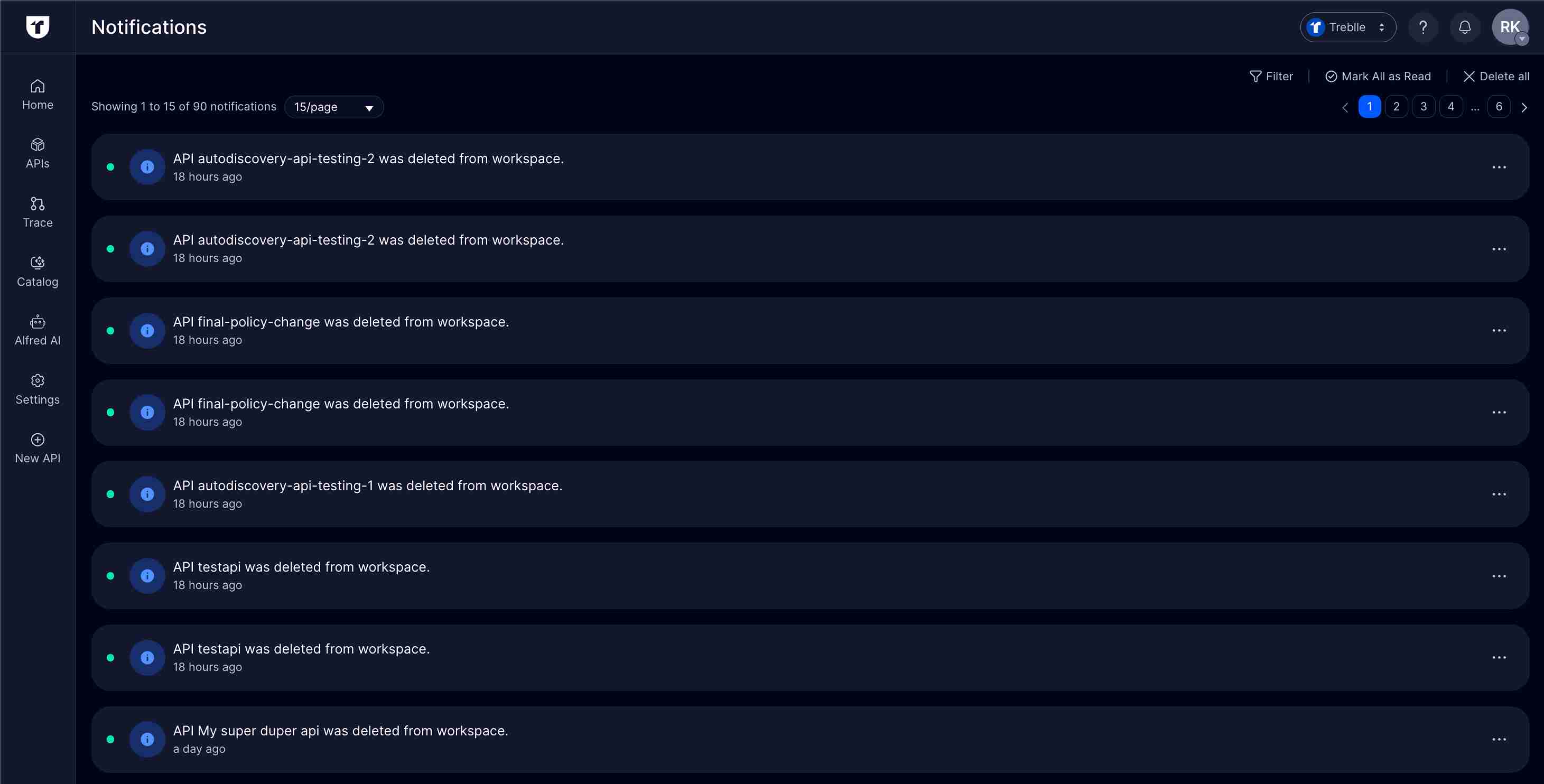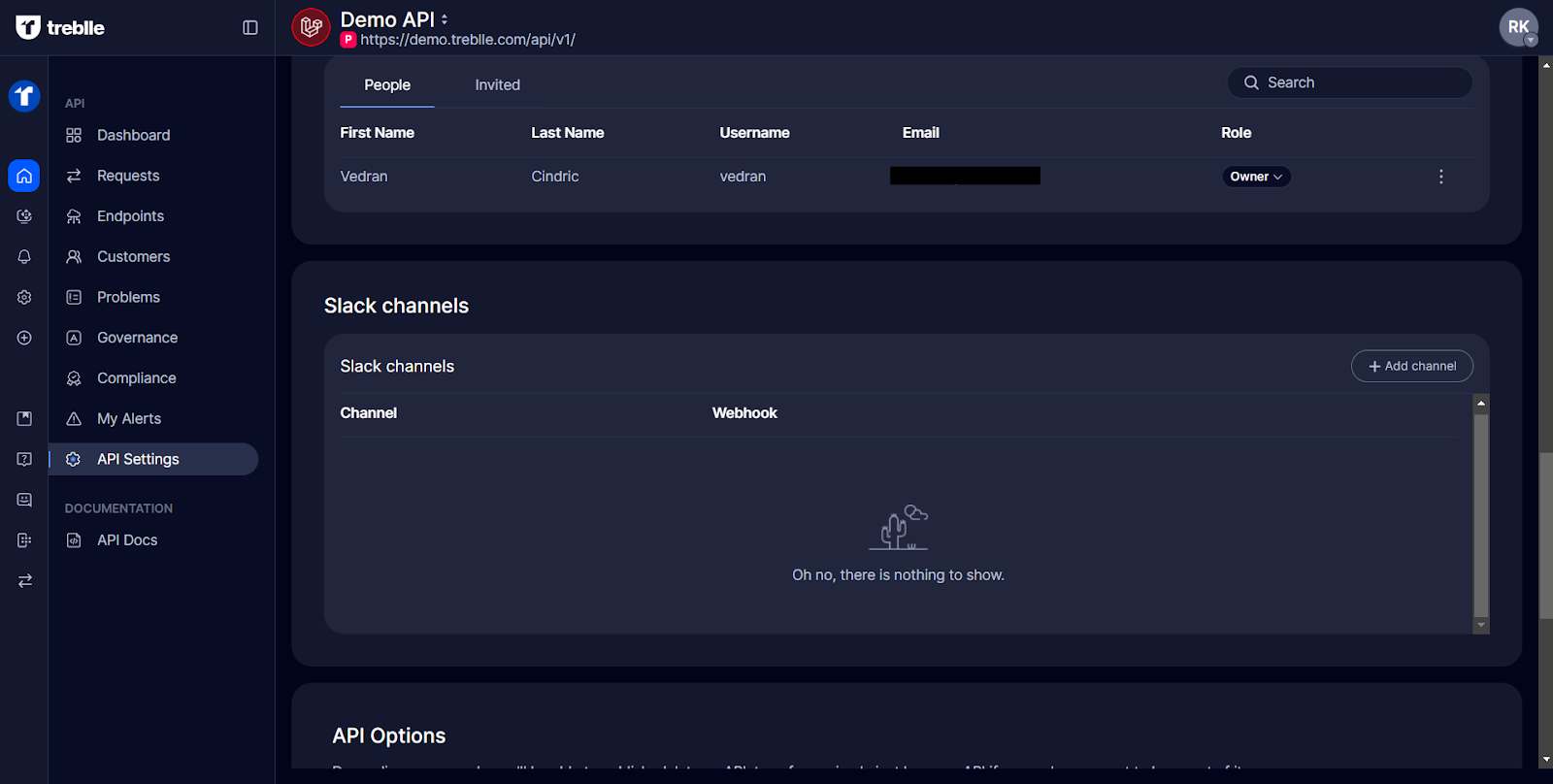Default Alerts
Treblle provides a comprehensive notification system that delivers intelligent alerts and real-time updates across multiple channels, designed to keep users informed without overwhelming them.
Default Notifications are system-level alerts that are automatically enabled for all users with smart defaults to ensure you never miss critical information about your APIs and account.
API & Workspace Notifications
Section titled “API & Workspace Notifications”Stay informed about important changes to your API landscape and team collaborations.
API Management Alerts
Section titled “API Management Alerts”- New API additions: Notifications when new endpoints or features are added to your APIs
- API deletions/deprecations: Critical notices about discontinued services or deprecated endpoints
- Configuration changes: Updates to API settings, authentication methods, or access controls
Team Collaboration
Section titled “Team Collaboration”- Member additions: Alerts when new team members join workspaces or projects
- Workspace invitations: Notifications for invites to collaborate on new workspaces or APIs
- Permission changes: Updates when user roles or access levels are modified
Performance Monitoring
Section titled “Performance Monitoring”- Error limit notifications: Automatic alerts when API error rates spike or approach critical thresholds (>50% error rate)
- Performance degradation: Warnings when response times exceed normal baselines
- Unusual traffic patterns: Notifications about unexpected spikes or drops in API usage
System Status Notifications
Section titled “System Status Notifications”Receive real-time updates about Treblle platform health and scheduled maintenance.
Service Health
Section titled “Service Health”- Service disruptions: Real-time alerts for outages or degraded performance affecting the Treblle platform
- Maintenance windows: Advance notifications about scheduled downtime and maintenance activities
- Performance updates: Information about platform improvements and optimizations
Security Alerts
Section titled “Security Alerts”- Security updates: Important security patches and platform updates
- Breach notifications: Immediate alerts about any security incidents (though Treblle maintains industry-leading security standards)
- Compliance changes: Updates about regulatory compliance features and requirements
Account & Billing Notifications
Section titled “Account & Billing Notifications”Keep track of your account status and subscription details with automated billing alerts.
Payment Management
Section titled “Payment Management”- Payment failures: Immediate notifications for failed transactions or expired payment methods
- Subscription changes: Confirmations for plan upgrades, downgrades, or renewals
- Invoice availability: Alerts when new invoices are generated and available for download
Usage Monitoring
Section titled “Usage Monitoring”- Usage thresholds: Proactive warnings when approaching plan limits or quota restrictions
- Overage notifications: Alerts if usage exceeds current plan allowances
- Plan recommendations: Suggestions for plan changes based on usage patterns
Notification Channels
Section titled “Notification Channels”Default alerts are delivered through multiple channels to ensure you receive critical information:
In-App Notifications
Section titled “In-App Notifications”-
Dashboard alerts: Visual indicators within the Treblle platform
-
Notification center: Centralized location for all recent alerts and updates
-
Status badges: Real-time status indicators for APIs and services

Email Notifications
Section titled “Email Notifications”-
Immediate alerts: Critical notifications sent instantly via email
-
Daily summaries: Consolidated daily reports for non-urgent updates
-
Weekly reports: Comprehensive weekly summaries of API health and performance

Browser Notifications
Section titled “Browser Notifications”-
Real-time alerts: Push notifications for urgent issues when using the Treblle platform
-
Permission-based: Opt-in browser notifications for immediate awareness

Managing Default Alerts
Section titled “Managing Default Alerts”While default alerts are automatically enabled with smart settings, you have control over your notification preferences:
Alert Frequency
Section titled “Alert Frequency”- Immediate: Real-time notifications for critical issues
- Batched: Grouped notifications to reduce notification fatigue
- Digest format: Summary reports at scheduled intervals
Severity Levels
Section titled “Severity Levels”- Critical: Immediate attention required (service outages, security issues)
- High: Important but not urgent (error rate spikes, performance issues)
- Medium: Informational updates (new features, team changes)
- Low: General notifications (usage reports, maintenance schedules)
Customization Options
Section titled “Customization Options”While these are default system alerts, you can:
- Adjust notification timing and frequency
- Choose preferred communication channels
- Set up additional custom alerts for specific scenarios
- Create team-specific notification rules
For more advanced notification customization, see our Custom Alerts documentation.